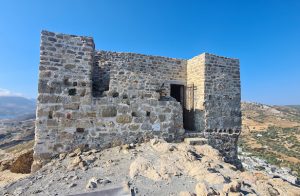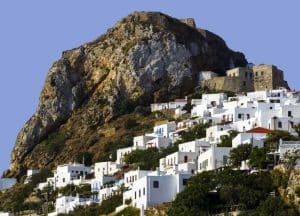History of the Skyros Castle

The Castle is divided into two levels: on the first level is the Monastery of Agios Georgios (963 AD) with a preserved part of the fortification.
On the second level are the restored Episcopal Church (895 AD), medieval water tanks, post-Byzantine naydria, ruins of buildings (provokades) as well as an important preserved part of the fortification which is mainly attributed to the medieval period.
The area
During the prehistoric period, it was probably the only place of habitation in the location of the current country of Skyros. The increase of the population during the Historical and Medieval times on the island led to the functioning, basically as an Acropolis, of the main settlement.

A landmark for the area was the foundation of the Episcopal Church of the Dormition in 895 AD. The Acropolis is being fortified again on the foundations of the ancient fortification, the walls are undergoing repeated repairs and additions, water reservoirs and houses are being built.
During Late Ottoman times the site occasionally functioned as a refuge in case of danger, with families maintaining a second household within the fortified area.
After the end of the Greek Revolution and the establishment of the Greek State, the monument was abandoned. In 1827, the last bishop of Skyros, Grigorios, who was the last permanent resident of the Castle of Skyros, died.
